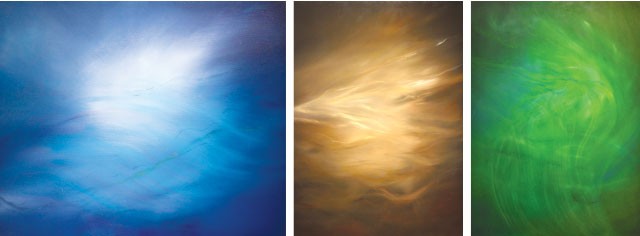Richly atmospheric and brilliantly colored, Julie Shipp’s abstract paintings evoke dramatic moments of sunlight shining through storm clouds or the disorienting sensation of floating, in an emerald sea without knowing which way is up or down. Partly inspired by 19th-century landscapes, her work can be described as “Turneresque,” but unlike J.M.W. Turner’s atmospheric paintings, Shipp leaves out the horizon line or any other easily recognizable aspect of nature, relying instead on the viewer’s innate tendency for pattern recognition to fill in the missing information.
Her series of 14 paintings on view at REM Gallery is titled Asperatus after the first new classification of clouds proposed in more than 50 years to the International Cloud Atlas of the World Meteorological Organization. Derived from the Latin verb aspero, which means “to make rough,” these dark, menacing-looking clouds appear like an upside-down sea in the sky and are common over the Midwest’s plains during the morning or midday hours following convective thunderstorm activity, though they tend to dissipate without a storm forming.
In her artist’s statement, Shipp notes this ephemeral effect is similar to the method she uses to create her work. The paint performs an active role on the surface by implying motion and illusionistic space. Subtle changes of light and color can be detected in each layer of paint. These quick flashes of changing light are frozen forever in her paintings, though they are intended to reflect the brief, transitory experience of life. While much abstract art is literally abstracted from reality, Shipp says her paintings are meant to be transcendental statements. Generally, they go beyond representation into a more spiritual and usually uplifting realm.
Asperatus 9 features bright yellow-orange light reflecting off the clouds broken by the straight lines of the sun’s rays, possibly created by using the blunt end of a brush to scrape away the paint. You also can read the painting as a solar flare or the aurora borealis. More recognizably read as a sunset is the bright red-orange 2. White wisps of clouds in 6 seem to be heralding the end of a storm with the sun breaking through the clouds, a sight that typically signifies relief or impending happiness.
Offering what seems to be the view from a passenger jet cruising at 35,000 feet is 1 — moody gray cloud tops creating a flat, featureless plain below strips of drifting, fragmented clouds in gold leaf, which twinkle mysteriously in the gallery’s spotlights. Searchlights stab upward through the darkness in 7, recalling wartime images of a bombed-out Berlin, although the horizon line is far below out of sight.
But not all the works appear to be skyscapes. It’s easy to imagine yourself as a diver looking up through strands of kelp beneath the shifting currents and undulating waves of 8, while 14 could be the space between the waves in a blue, green, and gold sea. A path through a forest in 50 shades of green appears to beckon in 3, although it also can be seen as the gaseous remnants of an exploded star.
Generally, Shipp’s larger paintings are more effective than her smaller canvases at providing an immersive panorama. Gray, whitish smoke swirls and coils through 4, although the lack of any points of reference make it the most difficult to tell what’s up or down. This painting probably comes closest to Turner’s later work, when he scraped, brushed, and smeared paint to create sweeping movements and to imply, rather than describe, both setting and details.
Of course, Turner was ridiculed for his later almost purely abstract paintings, while Shipp seems more in search of an approach that returns the abstract to an anchor in reality without sacrificing any hard-won art-for-art’s-sake formal values. While pattern recognition is innate to all animals, the human tendency to see patterns that do not actually exist is called “apophenia,” including seeing castles in the clouds and a portrait of Jesus on a burnt tortilla. And it may be in this gap between the real and the perceived that abstract art is most effective.
Julie Shipp: Asperatus
Free
Noon-6pm Fri-Sat
Reception 6pm-9pm Fri, June 14
REM Gallery
219 E Park
(210) 224-1227
remgallery.com















